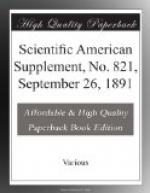Broadly speaking, an explosive compound is one which contains, within itself, all the elements necessary for its complete combustion, and whose heated gaseous products occupy vastly more space than the original compound. Such compound usually consists of oxygen, associated with other elements, for which it has great affinity, and from which it is held from more intimate union, or direct chemical combination, under normal conditions, by being in combination as well with other elements for which it has less affinity, but which it readily gives up for the stronger affinities when explosion takes place, the other elements either combining with one another to form new compounds or being set free in an uncombined state.
An explosive is said to detonate when the above changes take place instantaneously, the action being transmitted with the speed of electricity by a sort of molecular rhythm from molecule to molecule throughout the entire substance of the compound.
An explosive is said to explode when the above changes do not occur instantaneously throughout the whole substance, but whose combustion takes place from the surface inward of the particles or grains of which it is composed, thus requiring some definite lapse of time.
The elements of an explosive compound may be associated chemically as in nitro-glycerine and gun-cotton, which are chemical compounds, being the results of definite reactions. Or, an explosive may be a mere mechanical mixture of different substances comprising the necessary elements, as is ordinary black gunpowder, which is a compound of charcoal, sulphur and saltpeter, the saltpeter supplying the necessary oxygen.
No gunpowder can be smokeless in which saltpeter or any oxygen-bearing salt having a metallic base is employed, for when the salt gives up its oxygen, the base combines with other elements to produce a sulphate, a carbonate, or other salt, which, being solid, produces smoke. Therefore, to be smokeless, a gunpowder must contain no other elements than oxygen, hydrogen, nitrogen, and carbon, and in such proportions that the products of combustion shall be wholly gaseous. The nitric ethers—gun-cotton and nitro-glycerine—constitute such explosive compounds. These substances were formerly thought to be nitro-substitution compounds, but are now known to belong to the compound ethers of nitric acid.
Gun-cotton, discovered by Schonbein, in 1845, has since been looked upon as the most promising material for a smokeless gunpowder, it being a very powerful explosive and burning with practically no smoke. To-day, gun-cotton, in some form or other, constitutes the base of substantially all of the smokeless powders with which have been attained any considerable degree of success.




